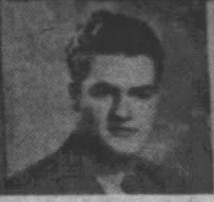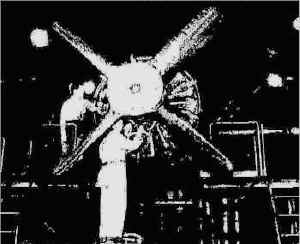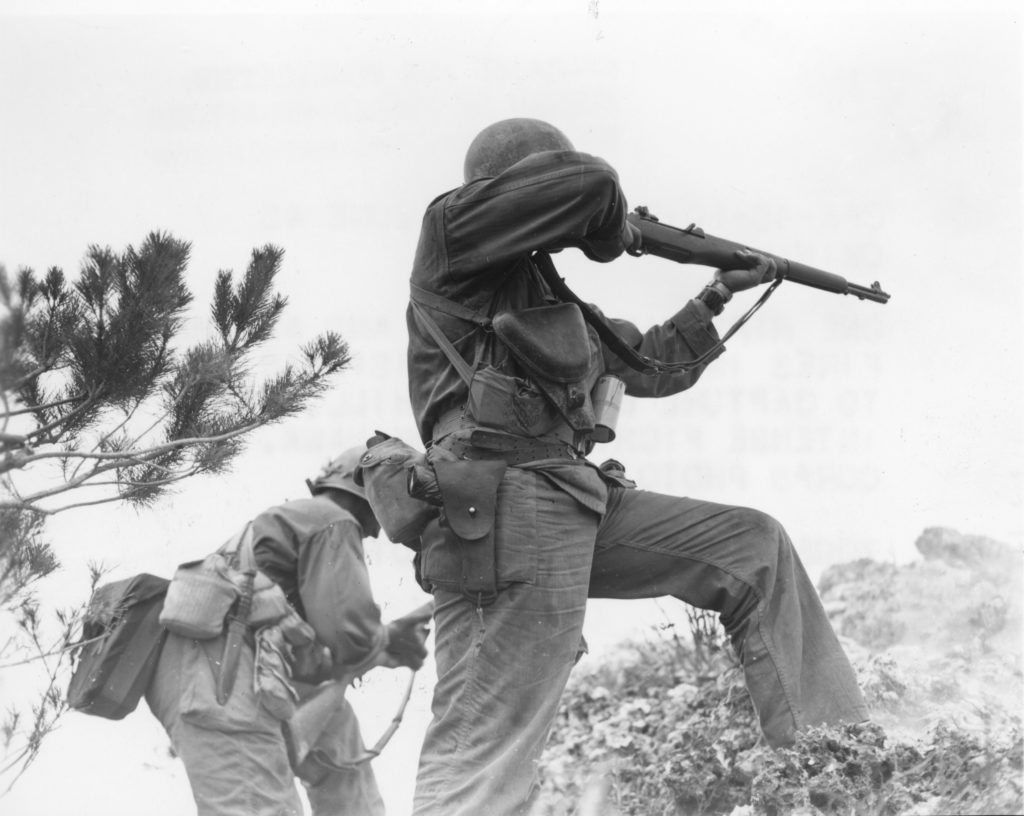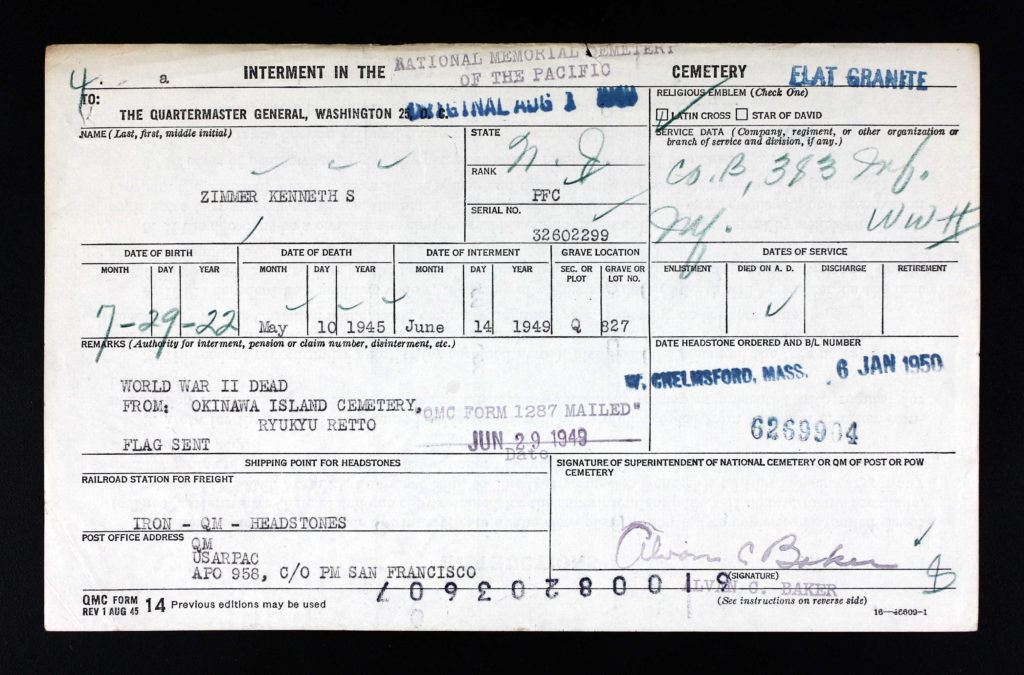Private First Class Kenneth S. Zimmer

- Unit: 96th Infantry Division, 383rd Infantry Regiment, Company B
- Service Number: 32602299
- Date of Birth: July 29, 1922
- Entered the Military: December 23, 1942
- Date of Death: May 10, 1945
- Hometown: Paterson, New Jersey
- Place of Death: Okinawa, Japan
- Award(s): Bronze Star, Purple Heart
Mentored by Ms. Jayne Jedlicka O’Neill
Passaic County Technical Vocational Schools
2022/2023
Early Life
Kenneth Stanely Zimmer was born July 29, 1922, and raised in Paterson, New Jersey. He was the only child of William and Maude Zimmer. As a young child, Kenneth attended the Oliver Wendell Holmes Elementary School. Later, he attended East Side High School in Paterson, New Jersey. After graduation from Eastside High School in January 1941, Kenneth Zimmer worked as a general clerk.


Homefront
Paterson, New Jersey, a suburb of New York City, was known as Silk City for their role in manufacturing silk. Paterson’s silk factories would be integral during World War II as manufacturers pivoted from silk production to nylon. During the war, nylon would be used in parachutes, ropes, and netting.
Paterson over 300 defense companies also played a huge role during World War II, producing vital defense materials.
The location of Paterson near nature’s Great Falls helped the industry expand and prosper. The falls provided an energy source that motorized plants in the surrounding area. Paterson became known as “The Aviation City” because the Curtiss-Wright Corporation was located in the city. Curtiss-Wright Paterson plant produced thousands of military aircraft engines, including the engines that powered the Boeing B-17 Flying Fortress and the B-25 Mitchell. The Wright engines benefited the American air forces throughout the world. Overall, the plants in the Paterson area produced a total of 142,000 aircraft engines. There was also an effort by local firefighters to help the war effort since Paterson was considered a “target area.” The Paterson Fire Department sent men to train at the Federal Chemical Warfare School in Maryland’s Edgewood Arsenal. Other firefighters served in World War II instead.


Military Experience
On December 23, 1942, Kenneth Zimmer was drafted in the United States Army. He would leave for Fort Dix nine days later, on January 1, 1943. Evidence suggests that he trained at Camp Adair, Oregon and then been assigned as part of the 96th Infantry Division, 383rd Infantry Regiment, Company B.
Private First Class Kenneth Stanley Zimmer and his unit participated in the Battle of Okinawa. Beginning on April 1, 1945, the battle was fought to take control of the key set of islands of Okinawa. The islands would provide a launching pad from which American troops could bomb Japan. In the end, control of Okinawa would allow the United States to block vital routes for the Japanese and allow for more airstrikes. As Okinawa was Japan’s last line of defense before the Japanese homeland, there would be a fierce battle and one of the bloodiest of the Pacific Theater.
Private First Class Kenneth Zimmer’s job was on the ground, working to destroy Japanese-controlled caves on the island. The caves were heavily defended, forcing Zimmer and his unit to face deadly fire as they sought to take control. Japanese forces hurled grenades from the caves and nearby ridges and fired down on American Infantrymen like Zimmer. During the Battle of Okinawa on May 10, 1945, Private First Class Kenneth Zimmer was killed in action by a gunshot wound to the abdomen.
The battle finally ended on June 22, 1945, ensuring American control of Okinawa. It resulted in over 12,000 American deaths and 36,000 casualties. The battle was also significant in the decision to use atomic weapons. The Battle of Okinawa was supposed to set the stage for the mainland invasion of Japan. After the staggering loss of life, President Harry S. Truman realized just how costly an invasion of Japan would be. In the end, Truman dropped two atomic bombs, leading to the war’s end.
Kenneth Zimmer was posthumously awarded the Purple Heart and Bronze Star. The Purple Heart was awarded to those who have been wounded or have died in the line of duty. The Bronze Star is given to those who served in the Armed Forces in a combat theater and have distinguished themselves through heroic action or outstanding achievement. Kenneth Zimmer was moved from his original burial place in a cemetery in Okinawa at the request of his father who wished for his son to be laid to rest overseas in Guam. He would eventually be laid to rest in the Honolulu due to Congress failing to pass legislation that would allow for burials in Guam.

Eulogy
Kenneth Zimmer, born in Paterson, New Jersey, would graduate from Eastside High School, choosing to work as a clerk in a local government office. On December 23, 1942, he was drafted into the United States Army.
In the prime of his life, Kenneth Zimmer heard the call for duty and was willing to face the challenges that lay ahead. Armed with the desire to protect his country, Zimmer joined the ranks of the 96th Infantry Division, 383rd Infantry Regiment, Company B. With his unit, Private First Class Zimmer fought to remove the last barrier between mainland Japan and the Allied forces. On April 1, 1945, Operation Iceberg, code name for the invasion of Okinawa and Ryukyu Islands, began. Those involved in the battle for Okinawa included Private First Class Zimmer’s Tenth Army, comprised of the 7th, 27th, and 96th Infantry Divisions. Refusing to surrender, the Japanese waged a savage battle against the American troops. These infantry divisions faced a ferocious fight, working to destroy the Japanese-held caves.Private First Class Kennenth Stanley Zimmer lost his life on May 10, 1945, from a gunshot wound to his abdomen.
The United States saw the events of Okinawa as one of their greatest victories, but the price paid on both sides was immeasurable. Private First Class Zimmer was one of more than 12,000 Americans who were killed in Okinawa. Their work led to the island of Okinawa falling into American hands, providing a vital airfield in the final drive against Japan, bringing about the Japanese surrender less than three months later. Posthumously, Private First Class Zimmer was awarded the Purple Heart as well as the Bronze Star for his gallantry during World War II. May he rest in peace.


Reflection
One of the most significant things I learned from the Sacrifice for Freedom®: World War II in the Pacific Student and Teacher Institute was the importance of remembering and honoring history and American heroes. When I discovered that my Silent Hero had no living family members, it became especially important to me to tell his story through my research. A moment I remember vividly was once we finished reading our eulogies and visited the graves of our silent heroes. After we finished paying our respects, Mr. Yamamoto, our guide, explained that we were probably the first ones to visit his grave since his parents. This statement reminded me of how critical the work done with Sacrifice for Freedom®: World War II in the Pacific Student and Teacher Institute is in honoring the fallen soldiers.
As I proceed with my journey into higher education, the research skills gained during this program will benefit me greatly. I learned that research is about putting the pieces together. I found that our job is to find these lost pieces of our veteran’s stories so they will not be lost. This program also allowed me to connect myself with my own community by looking through local archives as part of my research.
Because of the Sacrifice for Freedom®: World War II in the Pacific Student and Teacher Institute, I will share the story of my Silent Hero. I plan to teach others about the information and details shared with me on this trip. This information comes from the various museums and locations we visited. To me these stories and information are invaluable. They are not only part of American history, but the reality of the people who lived through World War II.
Preserving history is imperative to me because my generation may very well be the last to hear these stories from survivors or their children. I hope to keep the memories of those who have lived through World War II alive by engaging my community both at home and at school.
Overall my experience with Sacrifice for Freedom®: World War II in the Pacific Student and Teacher Institute is one I will not forget. I’ve become a better student, and person through it. There’s nothing I can think of that touches on the educational and hands-on learning of World War II like this program. It aims not only to teach but to honor, and I will take this mission as my own as I continue to grow and learn.
Bibliography
Primary Sources
96th Infantry Division Soldiers Firing a 37 MM Gun M3 at Japanese Forces Okinawa, 1945. Photograph. 1945. Gift of Sergeant Lyle E. Eberspecher, The National WWII Museum. https://www.ww2online.org/image/96th-infantry-division-soldiers-firing-37-mm-gun-m3-japanese-forces-okinawa-1945.
“Casualties.” The Herald-News [Passic, New Jersey]. June 28, 1945. Newspapers.com (526765478).
“Fourth Ward Men Listed by Board.” The News [Paterson, New Jersey], December 14, 1942. Newspapers.com (526091816).
“January 1941 Graduates at Eastside High.” The Paterson Evening News [Paterson, New Jersey], Jan uary 30, 1941. Newspapers.com (526144224).
Kenneth Zimmer. Individual Deceased Personnel File, Department of the Army.
Kenneth S. Zimmer. National Cemetery Interment Control Forms, 1928-1962. Digital images. https://ancestryclassroom.com.
Kenneth S. Zimmer. New Jersey Birth Index 1878-1890. Digital image. https://ancestryclassroom.com.
Kenneth S. Zimmer. U.S. Rosters of World War II Dead. 1939-1945. Digital Images. https://ancestryclassroom.com.
Kenneth S. Zimmer. U.S. World War II Navy Muster Rolls, 1938-1949. Digital Images. https://ancestryclassroom.com.
Kenneth S. Zimmer. World War II Draft Registration Cards Young Men, 1940-1947. Digital images. https://ancestryclassroom.com.
Kenneth S. Zimmer. World War II Hospital Admission Card Files, 1942-1954. https://ancestryclassroom.com.
Kenneth S. Zimmer. World War II Jewish Servicemen Cards, 1942-1947 U.S. Digital Image. https://ancestryclassroom.com.
New Jersey. Passaic County. 1930 U.S. Federal Census. Digital images. https://ancestryclassroom.com.
New Jersey. Passaic County. 1940 U.S. Federal Census. Digital images. https://ancestryclassroom.com.
One rifleman reloads, and another fires in the 96th Infantry Division’s advance to capture Big Apple Hill, scene of intense fighting on Okinawa. Photograph. National Archives and Records Administration (111-SC-337972). https://commons.wikimedia.org/wiki/File:111-SC-337972_-_One_rifleman_reloads,_and_another_fires_in_the_96th_Infantry_Division%27s_advance_to_capture_Big_Apple_Hill,_scene_of_intense_fighting_on_Okinawa.jpg.
“Pupils of School #13 Engage in Many Special Activities.” The Paterson Evening News [Paterson, New Jersey], October 26, 1929.
Secondary Sources
“96th Infantry Division.” U.S. Army Center of Military History. Accessed August 24, 2023. https://history.army.mil/html/forcestruc/cbtchron/cc/096id.htm.
“383rd Infantry Regiment.” U.S. Army Center of Military History. Accessed August 24, 2023. https://history.army.mil/html/forcestruc/lineages/branches/regt/0383rgt.htm.
“Battle of Okinawa.” The National WW II Museum. Accessed August 22, 2023. https://www.nationalww2museum.org/war/topics/battle-of-okinawa.
“Battle of Okinawa.” Naval History and Heritage Command. Updated May 3, 2022. Accessed August 24, 2023. https://www.history.navy.mil/browse-by-topic/wars-conflicts-and-operations/world-war-ii/1945/battle-of-okinawa.html.
Cohen, Robert L. “Aviation City.” The Historic County Newsletter, Fall 2011-Winter 2011. https://lambertcastle.org/wp-content/uploads/2017/02/2011-vol-11-no-34-fall_winter.pdf.
“Historical Sketch.” Special Collections and Research Center, Oregon State University. Accessed August 24, 2023. https://guides.library.oregonstate.edu/localhistory/adair.
“Intensification and Collapse of Japanese Resistance.” Encyclopedia Britannica. https://www.britannica.com/topic/Battle-of-Okinawa/Intensification-and-collapse-of-Japanese-resistance.
Jacob Wesley Zimmerli Collection. Oral History. Veterans History Project, Library of Congress. https://www.loc.gov/item/afc2001001.12534/.
“Other Important Industries In Paterson.” Paterson Great Falls Organization. Accessed June 1, 2023 http://patersongreatfalls.org/otherindustries.html
“Paterson, New Jersey.” National Park Service. Last modified December 5 2022. Accessed April 17, 2023. https://www.nps.gov/places/paterson-new-jersey.htm.
“PFC Kenneth S. Zimmer.” Find a Grave. Updated March 3, 2000. Accessed August 24, 2023. https://www.findagrave.com/memorial/3797535/kenneth-s-zimmer.
“Tributes.” Remember the Deadeyes. Accessed August 24, 2023. http://www.rememberthedeadeyes.com/DeadeyesTributes.html.
Wharton, Jan. “Remember the Deadeye.” Video File. YouTube. July 9, 2015. https://www.youtube.com/watch?v=xF8xTyu0A8I.
Vergun, David. “Why Was the Battle of Okinawa So Significant?” U.S.O. Updated June 22, 2021. Accessed August 22, 2023. https://www.uso.org/stories/3125-why-was-the-battle-of-okinawa-so-significant.


